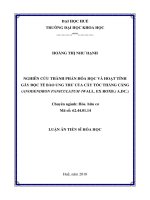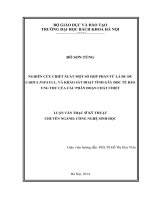Nghiên cứu chiết tách, phân lập và hoạt tính gây độc tế bào ung thư của hợp chất kaempferol 3 o α l rhamnopyranoside từ hoa đu đủ đực thu hái tại quảng nam đà nẵng
Bạn đang xem bản rút gọn của tài liệu. Xem và tải ngay bản đầy đủ của tài liệu tại đây (1.27 MB, 41 trang )
���������������������������������������������������������������������������������������������������������������������������������������������������������������������������������������������������������������������������������������������������������������������������������������������������������������������������������������������������������������������������������������������������������������������������������������������������������������������������������������������������������������������������������������������������������������������������������������������������������������������������������������������������������������������������������������������������������������������������������������������������������������������������������������������������������������������������������������������������������������������������������������������������������������������������������������������������������������������������������������������������������������������������������������������������������������������������������������������������������������������������������������������������������������������������������������������������������������������������������������������������������������������������������������������������������������������������������������������������������������������������������������������������������������������������������������������������������������������������������������������������������������������������������������������������������������������������������������������������������������������������������������������������������������������������������������������������������������������������������������������������������������������������������������������������������������������������������������������������������������������������������������������������������������������������������������������������������������������������������������������������������������������������������������������������������������������������������������������������������������������������������������������������������������������������������������������������������������������������������������������������������������������������������������������������������������������������������������������������������������������������������������������������������������������������������������������������������������������������������������������������������������������������������������������������������������������������������������������������������������������������������������������������������������������������������������������������������������������������������������������������������������������������������������������������������������������������������������������������������������������������������������������������������������������������������������������������������������������������������������������������������������������������������������������������������������������������������������������������������������������������������������������������������������������������������������������������������������������������������������������������������������������������������������������������������������������������������������������������������������������������������������������������������������������������������������������������������������������������������������������������������������������������������������������������������������������������������������������������������������������������������������������������������������������������������������������������������������������������������������������������������������������������������������������������������������������������������������������������������������������������������������������������������������������������������������������������������������������������������������������������������������������������������������������������������������������������������������������������������������������������������������������������������������������������������������������������������������������������������������������������������������������������������������������������������������������������������������������������������������������������������������������������������������������������������������������������������������������������������������������������������������������������������������������������������������������������������������������������������������������������������������������������������������������������������������������������������������������������������������������������������������������������������������������������������������������������������������������������������������������������������������������������������������������������������������������������������������������������������������������������������������������������������������������������������������������������������������������������������������������������������������������������������������������������������������������������������������������������������������������������������������������������������������������������������������������������������������������������������������������������������������������������������������������������������������������������������������������������������������������������������������������������������������������������������������������������������������������������������������������������������������������������������������������������������������������������������������������������������������������������������������������������������������������������������������������������������������������������������������������������������������������������������������������������������������������������������������������������������������������������������������������������������������������������������������������������������������������������������������������������������������������������������������������������������������������������������������������������������������������������������������������������������������������������������������������������������������������������������������������������������������������������������������������������������������������������������������������������������������������������������������������������������������������������������������������������������������������������������������������������������������������������������������������������������������������������������������������������������������������������������������������������������������������������������������������������������������������������������������������������������������������������������������������������������������������������������������������������������������������������������������������������������������������������������������������������������������������������������������������������������������������������������������������������������������������������������������������������������������������������������������������������������������������������������������������������������������������������������������������������������������������������������������������������������������������������������������������������������������������������������������������������������������������������������������������������������������������������������������������������������������������������������������������������������������������������������������������������������������������������������������������������������������������������������������������������������������������������������������������������������������������������������������������������������������������������������������������������������������������������������������������������������������������������������������������������������������������������������������������������������������������������������������������������������������������������������������������������������������������������������������������������������������������������������������������������������������������������������������������������������������������������������������������������������������������������������������������������������������������������������������������������������������������������������������������������������������������������������������������������������������������������������������������������������������������������������������������������������������������������������������������������������������������������������������������������������������������������������������������������������������������������������������������������������������������������������������������������������������������������������������������������������������������������������������������������������������������������������������������������������������������������������������������������������������������������������������������������������������������������������������������������������������������������������������������������������������������������������������������������������������������������������������������������������������������������������������������������������������������������������������������������������������������������������������������������������������������������������������������������������������������������������������������������������������������������������������������������������������������������������������������������������������������������������������������������������������������������������������������������������������������������������������������������������������������������������������������������������������������������������������������������������������������������������������������������������������������������������������������������������������������������������������������������������������������������������������������������������������������������������������������������������������������������������������������������������������������������������������������������������������������������������������������������������������������������������������������������������������������������������������������������������������������������������������������������������������������������������������������������������������������������������������������������������������������������������������������������������������������������������������������������������������������������������������������������������������������������������������������������������������������������������������������������������������������������������������������������������������������������������������������������������������������������������������������������������������������������������������������������������������������������������������������������������������������������������������������������������������������������������������������������������������������������������������������������������������������������������������������������������������������������������������������������������������������������������������������������������������������������������������������������������������������������������������������������������������������������������������������������������������������������������������������������������������������������������������������������������������������������������������������������������������������������������������������������������������������������������������������������������������������������������������������������������������������������������������������������������������������������������������������������������������������������������������������������������������������������������������������������������������������������������������������������������������������������������������������������������������������������������������������������������������������������������������������������������������������������������������������������������������������������������������������������������������������������������������������������������������������������������������������������������������������������������������������������������������������������������������������������������������������������������������������������������������������������������������������������������������������������������������������������������������������������������������������������������������������������������������������������������������������������������������������������������������������������������������������������������������������������������������������������������������������������������������������������������������������������������������������������������������������������������������������������������������������������������������������������������������������������������������������������������������������������������������������������������������������������������������������������������������������������������������������������������������������������������������������������������������������������������������������������������������������������������������������������������������������������������������������������������������������������������������������������������������������������������������������������������������������������������������������������������������������������������������������������������������������������������������������������������������������������������������������������������������������������������������������������������������������������������������������������������������������������������������������������������������������������������������������������������������������������������������������������������������������������������������������������������������������������������������������������������������������������������������������������������������������������������������������������������������������������������������������������������������������������������������������������������������������������������������������������������������������������������������������������������������������������������������������������������������������������������������������������������������������������������������������������������������������������������������������������������������������������������������������������������������������������������������������������������������������������������������������������������������������������������������������������������������������������������������������������������������������������������������������������������������������������������������������������������������������������������������������������������������������������������������������������������������������������������������������������������������������������������������������������������������������������������������������������������������������������������������������������������������������������������������������������������������������������������������������������������������������������������������������������������������������������������������������������������������������������������������������������������������������������������������������������������������������������������������������������������������������������������������������������������������������������������������������������������������������������������������������������������������������������������������������������������������������������������������������������������������������������������������������������������������������������������������������������������������������������������������������������������������������������������������������������������������������������������������������������������������������������������������������������������������������������������������������������������������������������������������������������������������������������������������������������������������������������������������������������������������������������������������������������������������������������������������������������������������������������������������������������������������������������������������������������������������������������������������������������������������������������������������������������������������������������������������������������������������������������������������������������������������������������������������������������������������������������������������������������������������������������������������������������������������������������������������������������������������������������������������������������������������������������������������������������������������������������������������������������������������������������������������������������������������������������������������������������������������������������������������������������������������������������������������������������������������������������������������������������������������������������������������������������������������������������������������������������������������������������������������������������������������������������������������������������������������������������������������������������������������������������������������������������������������������������������������������������������������������������������������������������������������������������������������������������������������������������������������������������������������������������������������������������������������������������������������������������������������������������������������������������������������������������������������������������������������������������������������������������������������������������������������������������������������������������������������������������������������������������������������������������������������������������������������������������������������������������������������������������������������������������������������������������������������������������������������������������������������������������������������������������������������������������������������������������������������������������������������������������������������������������������������������������������������������������������������������������������������������������������������������������������������������������������������������������������������������������������������������������������������������������������������������������������������������������������������������������������������������������������������������������������������������������������������������������������������������������������������������������������������������������������������������������������������������������������������������������������������������������������������������������������������������������������������������������������������������������������������������������������������������������������������������������������������������������������������������������������������������������������������������������������������������������������������������������������������������������������������������������������������������������������������������������������������������������������������������������������������������������������������������������������������������������������������������������������������������������������������������������������������������������������������������������������������������������������������������������������������������������������������������������������������������������������������������������������������������������������������������������������������������������������������������������������������������������������������������������������������������������������������������������������������������������������������������������������������������������������������������������������������������������������������������������������������������������������������������������������������������������������������������������������������������������������������������������������������������������������������������������������������������������������������������������������������������������������������������������������������������������������������������������������������������������������������������������������������������������������������������������������������������������������������������������������������������������������������������������������������������������������������������������������������������������������������������������������������������������������������������������������������������������������������������������������������������������������������������������������������������������������������������������������������������������������������������������������������������������������������������������������������������������������������������������������������������������������������������������������������������������������������������������������������������������������������������������������������������������������������������������������������������������������������������������������������������������������������������������������������������������������������������������������������������������������������������������������������������������������������������������������������������������������������������������������������������������������������������������������������������������������������������������������������������������������������������������������������������������������������������������������������������������������������������������������������������������������������������������������������������������������������������������������������������������������������������������������������������������������������������������������������������������������������������������������������������������������������������������������������������������������������������������������������������������������������������������������������������������������������������������������������������������������������������������������������������������������������������������������������������������������������������������������������������������������������������������������������������������������������������������������������������������������������������������������������������������������������������������������������������������������������������������������������������������������������������������������������������������������������������������������������������������������������������������������������������������������������������������������������������������������������������������������������������������������������������������������������������������������������������������������������������������������������������������������������������������������������������������������������������������������������������������������������������������������������������������������������������������������������������������������������������������������������������������������������������������������������������������������������������������������������������������������������������������������������������������������������������������������������������������������������������������������������������������������������������������������������������������������������������������������������������������������������������������������������������������������������������������������������������������������������������������������������������������������������������������������������������������������������������������������������������������������������������������������������������������������������������������������������������������������������������������������������������������������������������������������������������������������������������������������������������������������������������������������������������������������������������������������������������������������������������������������������������������������������������������������������������������������������������������������������������������������������������������������������������������������������������������������������������������������������������������������������������������������������������������������������������������������������������������������������������������������������������������������������������������������������������������������������������������������������������������������������������������������������������������������������������������������������������������������������������������������������������������������������������������������������������������������������������������������������������������������������������������������������������������������������������������������������������������������������������������������������������������������������������������������������������������������������������������������������������������������������������������������������������������������������������������������������������������������������������������������������������������������������������������������������������������������������������������������������������������������������������������������������������������������������������������������������������������������������������������������������������������������������������������������������������������������������������������������������������������������������������������������������������������������������������������������������������������������������������������������������������������������������������������������������������������������������������������������������������������������������������������������������������������������������������������������������������������������������������������������������������������������������������������������������������������������������������������������������������������������������������������������������������������������������������������������������������������������������������������������������������������������������������������������������������������������������������������������������������������������������������������������������������������������������������������������������������������������������������������������������������������������������������������������������������������������������������������������������������������������������������������������������������������������������������������������������������������������������������������������������������������������������������������������������������������������������������������������������������������������������������������������������������������������������������������������������������������������������������������������������������������������������������������������������������������������������������������������������������������������������������������������������������������������������������������������������������������������������������������������������������������������������������������������������������������������������������������������������������������������������������������������������������������������������������������������������������������������������������������������������������������������������������������������������������������������������������������������������������������������������������������������������������������������������������������������������������������������������������������������������������������������������������������������������������������������������������������������������������������������������������������������������������������������������������������������������������������������������������������������������������������������������������������������������������������������������������������������������������������������������������������������������������������������������������������������������������������������������������������������������������������������������������������������������������������������������������������������������������������������������������������������������������������������������������������������������������������������������������������������������������������������������������������������������������������������������������������������������������������������������������������������������������������������������������������������������������������������������������������������������������������������������������������������������������������������������������������������������������������������������������������������������������������������������������������������������������������������������������������������������������������������������������������������������������������������������������������������������������������������������������������������������������������������������������������������������������������������������������������������������������������������������������������������������������������������������������������������������������������������������������������������������������������������������������������������������������������������������������������������������������������������������������������������������������������������������������������������������������������������������������������������������������������������������������������������������������������������������������������������������������������������������������������������������������������������������������������������������������������������������������������������������������������������������������������������������������������������������������������������������������������������������������������������������������������������������������������������������������������������������������������������������������������������������������������������������������������������������������������������������������������������������������������������������������������������������������������������������������������������������������������������������������������������������������������������������������������������������������������������������������������������������������������������������������������������������������������������������������������������������������������������������������������������������������������������������������������������������������������������������������������������������������������������������������������������������������������������������������������������������������������������������������������������������������������������������������������������������������������������������������������������������������������������������������������������������������������������������������������������������������������������������������������������������������������������������������������������������������������������������������������������������������������������������������������������������������������������������������������������������������������������������������������������������������������������������������������������������������������������������������������������������������������������������������������������������������������������������������������������������������������������������������������������������������������������������������������������������������������������������������������������������������������������������������������������������������������������������������������������������������������������������������������������������������������������������������������������������������������������������������������������������������������������������������������������������������������������������������������������������������������������������������������������������������������������������������������������������������������������������������������������������������������������������������������������������������������������������������������������������������������������������������������������������������������������������������������������������������������������������������������������������������������������������������������������������������������������������������������������������������������������������������������������������������������������������������������������������������������������������������������������������������������������������������������������������������������������������������������������������������������������������������������������������������������������������������������������������������������������������������������������������������������������������������������������������������������������������������������������������������������������������������������������������������������������������������������������������������������������������������������������������������������������������������������������������������������������������������������������������������������������������������������������������������������������������������������������������������������������������������������������������������������������������������������������������������������������������������������������������������������������������������������������������������������������������������������������������������������������������������������������������������������������������������������������������������������������������������������������������������������������������������������������������������������������������������������������������������������������������������������������������������������������������������������������������������������������������������������������������������������������������������������������������������������������������������������������������������������������������������������������������������������������������������������������������������������������������������������������������������������������������������������������������������������������������������������������������������������������������������������������������������������������������������������������������������������������������������������������������������������������������������������������������������������������������������������������������������������������������������������������������������������������������������������������������������������������������������������������������������������������������������������������������������������������������������������������������������������������������������������������������������������������������������������������������������������������������������������������������������������������������������������������������������������������������������������������������������������������������������������������������������������������������������������������������������������������������������������������������������������������������������������������������������������������������������������������������������������������������������������������������������������������������������������������������������������������������������������������������������������������������������������������������������������������������������������������������������������������������������������������������������������������������������������������������������������������������������������������������������������������������������������������������������������������������������������������������������������������������������������������������������������������������������������������������������������������������������������������������������������������������������������������������������������������������������������������������������������������������������������������������������������������������������������������������������������������������������������������������������������������������������������������������������������������������������������������������������������������������������������������������������������������������������������������������������������������������������������������������������������������������������������������������������������������������������������������������������������������������������������������������������������������������������������������������������������������������������������������������������������������������������������������������������������������������������������������������������������������������������������������������������������������������������������������������������������������������������������������������������������������������������������������������������������������������������������������������������������������������������������������������������������������������������������������������������������������������������������������������������������������������������������������������������������������������������������������������������������������������������������������������������������������������������������������������������������������������������������������������������������������������������������������������������������������������������������������������������������������������������������������������������������������������������������������������������������������������������������������������������������������������������������������������������������������������������������������������������������������������������������������������������������������������������������������������������������������������������������������������������������������������������������������������������������������������������������������������������������������������������������������������������������������������������������������������������������������������������������������������������������������������������������������������������������������������������������������������������������������������������������������������������������������������������������������������������������������������������������������������������������������������������������������������������������������������������������������������������������������������������������������������������������������������������������������������������������������������������������������������������������������������������������������������������������������������������������������������������������������������������������������������������������������������������������������������������������������������������������������������������������������������������������������������������������������������������������������������������������������������������������������������������������������������������������������������������������������������������������������������������������������������������������������������������������������������������������������������������������������������������������������������������������������������������������������������������������������������������������������������������������������������������������������������������������������������������������������������������������������������������������������������������������������������������������������������������������������������������������������������������������������������������������������������������������������������������������������������������������������������������������������������������������������������������������������������������������������������������������������������������������������������������������������������������������������������������������������������������������������������������������������������������������������������������������������������������������������������������������������������������������������������������������������������������������������������������������������������������������������������������������������������������������������������������������������������������������������������������������������������������������������������������������������������������������������������������������������������������������������������������������������������������������������������������������������������������������������������������������������������������������������������������������������������������������������������������������������������������������������������������������������������������������������������������������������������������������������������������������������������������������������������������������������������������������������������������������������������������������������������������������������������������������������������������������������������������������������������������������������������������������������������������������������������������������������������������������������������������������������������������������������������������������������������������������������������������������������������������������������������������������������������������������������������������������������������������������������������������������������������������������������������������������������������������������������������������������������������������������������������������������������������������������������������������������������������������������������������������������������������������������������������������������������������������������������������������������������������������������������������������������������������������������������������������������������������������������������������������������������������������������������������������������������������������������������������������������������������������������������������������������������������������������������������������������������������������������������������������������������������������������������������������������������������������������������������������������������������������������������������������������������������������������������������������������������������������������������������������������������������������������������������������������������������������������������������������������������������������������������������������������������������������������������������������������������������������������������������������������������������������������������������������������������������������������������������������������������������������������������������������������������������������������������������������������������������������������������������������������������������������������������������������������������������������������������������������������������������������������������������������������������������������������������������������������������������������������������������������������������������������������������������������������������������������������������������������������������������������������������������������������������������������������������������������������������������������������������������������������������������������������������������������������������������������������������������������������������������������������������������������������������������������������������������������������������������������������������������������������������������������������������������������������������������������������������������������������������������������������������������������������������������������������������������������������������������������������������������������������������������������������������������������������������������������������������������������������������������������������������������������������������������������������������������������������������������������������������������������������������������������������������������������������������������������������������������������������������������������������������������������������������������������������������������������������������������������������������������������������������������������������������������������������������������������������������������������������������������������������������������������������������������������������������������������������������������������������������������������������������������������������������������������������������������������������������������������������������������������������������������������������������������������������������������������������������������������������������������������������������������������������������������������������������������������������������������������������������������������������������������������������������������������������������������������������������������������������������������������������������������������������������������������������������������������������������������������������������������������������������������������������������������������������������������������������������������������������������������������������������������������������������������������������������������������������������������������������������������������������������������������������������������������������������������������������������������������������������������������������������������������������������������������������������������������������������������������������������������������������������������������������������������������������������������������������������������������������������������������������������������������������������������������������������������������������������������������������������������������������������������������������������������������������������������������������������������������������������������������������������������������������������������������������������������������������������������������������������������������������������������������������������������������������������������������������������������������������������������������������������������������������������������������������������������������������������������������������������������������������������������������������������������������������������������������������������������������������������������������������������������������������������������������������������������������������������������������������������������������������������������������������������������������������������������������������������������������������������������������������������������������������������������������������������������������������������������������������������������������������������������������������������������������������������������������������������������������������������������������������������������������������������������������������������������������������������������������������������������������������������������������������������������������������������������������������������������������������������������������������������������������������������������������������������������������������������������������������������������������������������������������������������������������������������������������������������������������������������������������������������������������������������������������������������������������������������������������������������������������������������������������������������������������������������������������������������������������������������������������������������������������������������������������������������������������������������������������������������������������������������������������������������������������������������������������������������������������������������������������������������������������������������������������������������������������������������������������������������������������������������������������������������������������������������������������������������������������������������������������������������������������������������������������������������������������������������������������������������������������������������������������������������������������������������������������������������������������������������������������������������������������������������������������������������������������������������������������������������������������������������������������������������������������������������������������������������������������������������������������������������������������������������������������������������������������������������������������������������������������������������������������������������������������������������������������������������������������������������������������������������������������������������������������������������������������������������������������������������������������������������������������������������������������������������������������������������������������������������������������������������������������������������������������������������������������������������������������������������������������������������������������������������������������������������������������������������������������������������������������������������������������������������������������������������������������������������������������������������������������������������������������������������������������������������������������������������������������������������������������������������������������������������������������������������������������������������������������������������������������������������������������������������������������������������������������������������������������������������������������������������������������������������������������������������������������������������������������������������������������������������������������������������������������������������������������������������������������������������������������������������������������������������������������������������������������������������������������������������������������������������������������������������������������������������������������������������������������������������������������������������������������������������������������������������������������������������������������������������������������������������������������������������������������������������������������������������������������������������������������������������������������������������������������������������������������������������������������������������������������������������������������������������������������������������������������������������������������������������������������������������������������������������������������������������������������������������������������������������������������������������������������������������������������������������������������������������������������������������������������������������������������������������������������������������������������������������������������������������������������������������������������������������������������������������������������������������������������������������������������������������������������������������������������������������������������������������������������������������������������������������������������������������������������������������������������������������������������������������������������������������������������������������������������������������������������������������������������������������������������������������������������������������������������������������������������������������������������������������������������������������������������������������������������������������������������������������������������������������������������������������������������������������������������������������������������������������������������������������������������������������������������������������������������������������������������������������������������������������������������������������������������������������������������������������������������������������������������������������������������������������������������������������������������������������������������������������������������������������������������������������������������������������������������������������������������������������������������������������������������������������������������������������������������������������������������������������������������������������������������������������������������������������������������������������������������������������������������������������������������������������������������������������������������������������������������������������������������������������������������������������������������������������������������������������������������������������������������������������������������������������������������������������������������������������������������������������������������������������������������������������������������������������������������������������������������������������������������������������������������������������������������������������������������������������������������������������������������������������������������������������������������������������������������������������������������������������������������������������������������������������������������������������������������������������������������������������������������������������������������������������������������������������������������������������������������������������������������������������������������������������������������������������������������������������������������������������������������������������������������������������������������������������������������������������������������������������������������������������������������������������������������������������������������������������������������������������������������������������������������������������������������������������������������������������������������������������������������������������������������������������������������������������������������������������������������������������������������������������������������������������������������������������������������������������������������������������������������������������������������������������������������������������������������������������������������������������������������������������������������������������������������������������������������������������������������������������������������������������������������������������������������������������������������������������������������������������������������������������������������������������������������������������������������������������������������������������������������������������������������������������������������������������������������������������������������������������������������������������������������������������������������������������������������������������������������������������������������������������������������������������������������������������������������������������������������������������������������������������������������������������������������������������������������������������������������������������������������������������������������������������������������������������������������������������������������������������������������������������������������������������������������������������������������������������������������������������������������������������������������������������������������������������������������������������������������������������������������������������������������������������������������������������������������������������������������������������������������������������������������������������������������������������������������������������������������������������������������������������������������������������������������������������������������������������������������������������������������������������������������������������������������������������������������������������������������������������������������������������������������������������������������������������������������������������������������������������������������������������������������������������������������������������������������������������������������������������������������������������������������������������������������������������������������������������������������������������������������������������������������������������������������������������������������������������������������������������������������������������������������������������������������������������������������������������������������������������������������������������������������������������������������������������������������������������������������������������������������������������������������������������������������������������������������������������������������������������������������������������������������������������������������������������������������������������������������������������������������������������������������������������������������������������������������������������������������������������������������������������������������������������������������������������������������������������������������������������������������������������������������������������������������������������������������������������������������������������������������������������������������������������������������������������������������������������������������������������������������������������������������������������������������������������������������������������������������������������������������������������������������������������������������������������������������������������������������������������������������������������������������������������������������������������������������������������������������������������������������������������������������������������������������������������������������������������ch chiết ethyl acetate của hoa đu đủ đực.
- Thăm dị các hoạt tính sinh học khác của chất đã phân lập được cũng như
dịch chiết và các hợp chất phân lập được khác.
27
TÀI LIỆU THAM KHẢO
Tiếng Việt
[1]. Đỡ Huy Bích, Đặng Quang Chung (2006), Cây thuốc và động vật làm thuốc ở
Việt Nam, Nhà xuất bản Khoa học kỹ thuật, tập 1, pp 824-827.
[2]. Nguyễn Văn Đàm, Nguyễn Viết Tựu (1985), Phương pháp nghiên cứu hóa học
cây thuốc, Nxb Y học, Hà Nội.
[3]. Đỗ Trung Đàm (1996), Phương pháp xác định độc tính cấp của thuốc, Nxb Y
học, Hà Nội.
[4]. Trần Thanh Hà, Trịnh Thị Điệp (2012) “Hai cycloratane triterpene lần đầu tiên
phân lập từ lá Đu đủ (carica papaya L.)“, Tạp chí hóa họctập 50 (4A), pp 166-169.
[5]. Hồ Thị Hà (2014), Nghiên cứu hoạt tính sinh học của một số hợp chất chiết
tách từ lá Đu đủ(Carica papaya Linn), Luận án tiến sĩ. Đại học Bách khoa Hà nội.
[6]. Giang Thị Kim Liên và Đỗ Thị Lệ Uyên (2015),“Khảo sát thành phần hoá học
của một số dịch chiết từ hoa Đu đủ đực thu hái tại Đà Nẵng“,Tạp chí Khoa học
Công nghệ ĐHĐN; Số 03(88) ; Trang 119.
[7]. Đỗ Tất Lợi (1986), Những cây thuốc và vị thuốc Việt Nam, Nxb Khoa học và kỹ
thuật, Hà Nội,Trang 360-362.
[8]. Phạm Kim Mãn và cộng sự (2001),“Nghiên cứu thuốc Panacrin ức chế u dùng
trong điều trị ung thư“, Tạp chí dược liệu, 6(2+3), pp 58-62.
[9]. Hà Thị Bích Ngọc, Trần Thị Huyền Nga, Nguyễn Văn Mùi (2007) ‘‘Điều tra
hợp chất carotenoid trong một số thực vật của Việt Nam“, Tạp chí khoa học
ĐHQGHN, khoa học tự nhiên và công nghệ, (23), pp 130-134.
[10] Nguyễn Văn Rư, Vũ Quang Thái, (2013) "Tách chiết chymopapain từ nhựa
quả Đu đủ xanh (Carica papaya) và chế thử thành dạng bột để pha tiêm", Tạp chí
Hóa Học 50(6): 767-771.
[11]. Trần Thế Tục, Đoàn Thế Lư (2004),Cây Đu đủ và kỹ thuật trồng, Nxb lao
động xã hội.
[12]. Đỗ Thị Thảo (2006) Nghiên cứu xác định khả năng phòng chống ung thư và
bản chất hóa học của một số cây thuốc Việt Nam, Luận án tiến sĩ sinh học.
28
[13]. Nguyễn Tường Vân, Đặng Hồng Vân, Phạm Gia Khôi, Trần Mạnh Bình,
Phan Quốc Kinh (1983) “Chiết xuất và xác định carpaine alkaloid của lá Đu
đủ‘‘,Tạp chí dược học số 4.
[14]. Viện Dược liệu- Bộ Y tế (2006), Phương pháp nghiên cứu tác dụng dược lý củathuốc từ
dược thảo, Nhà xuất bản Khoa học và kỹ thuật- Hà Nội.
[15]. Đỗ Quốc Việt, Nghiên cứu thành phần hoá học và hoạt tính sinh học của cây
bầu đất (Gynura sarmentosa DC.), cây cải đồng (Grangea maderaspatana poir.)
và quả chuối hột (Musa balbisiana colla), Luận án tiến sĩ (2006).
Tiếng Anh
[16]. Aravind G., Debjit Bhowmik, Duraivel. S., Harish G. (2013) ‘’Traditional and
medicinal uses of carica papaya”, Journal of medicinal plants studies, vol 1, Issue
1,pp 7-15.
[17]. Asmah Rahmat, Rozita Rosli, Wan Nor I`zzah Wan Mohd. Zain, Susi Endrini
and Huzaimah Abdullah Sani (2002) “Antiproliferative Activity of Pure Lycopene
Compared to Both Extracted Lycopene and Juices from Watermelon (Citrullus
vulgaris) and Papaya (Caricapapaya) on Human Breast and Liver Cancer Cell
Lines”,Journal of Medical Sciences, vol 2.Isuae 2.page 55-58.
[18]. Abrham W.B., (1978), “Techniques of Animal and Clinical toxicology”, Med. Pub.
Chicago, p 55 – 68.
[19]. Antonella Canini, Daniela Alesiani, Giuseppe D’Arcangelo, Pietro Tagliatesta
(2007) “Gas chromatography-mass spectrometry analysis of phenolic compounds
from carica papaya L. leaf”,Journal of food composition and analysis, vol 20, pp
584-590.
[20]. Beverly A. Teicher, (1997), Anticancer drug development guide: Preclinical
screening, clinical trials, and approval, Humana Press, Totowa, New Jersey.
[21]. Bamidele V, Owoyele, Olubori M, Adebukola, Adeoye A, Funmilayo and
Ayodele O, Soladoye (2008) “Anti - inflammatory activities of ethanolic extract of
Carica papaya leave”, Inflammopharmacology, 16 (2008), pp 168 – 173.
[22]. Chung-Shih Tang (1979) “New macrocyclic Δ1–piperideine alkaloids from
papaya leaves: dehydrocarpaine I and II”,Phytochemistry, 1979, vol 18, pp 651652.
29
[23]. David S., Seigler, Guido F., Pauli, Adolf Nahrstedt, Rosemary Leen (2002)
“Cyanogenic allosides and glucosides from passiflora edulis and carica papaya”,
Phytochemistry, vol 60, pp 873-882.
[24]. Eno AE, Owo OI, Itam EH, Konya RS, (2000), “Blood pressure depression
by the fruit juice of Carica papaya (L.) in renal and DOCA-induced hypertension
in the rat”, Phytother Res, Jun;14(4):235-9.
[25]. Gopalakrishnan M, Rajasekharasetty MR., (1978 ), “Effect of papaya(Carica
papaya Linn) on pregnancy and estrous cycle in albino rats of Wistar strain”,
Indian J Physiol Pharmacol, Jan-Mar;22(1):66-70.
[26]. Giordani R., Cardenas M.L., Moulin-Traffort J., Regli P., (1996), “Fungicidal
activity of latex sap from Carica papaya and antifungal effect of D(+)-glucosamine
on Candida albicans growth”, Mycoses, 39, 103-110.
[27]. Govindachari T.R., Naga rajan K. and Viswanathan N. (1965) “Carpaine and
pseudocarpaine”, Tetrahedron letters No 24, pp 1907-1916.
[28]. Hewitt H, Whittle S, Lopez S, Bailey E, Weaver S,(2000), “Topical use of
papaya in chronic skin ulcer therapy in Jamaica”, West Indian Med J. Mar;
49(1):32-3.
[29]. John R., Van (1998), “Mechanism of Action of Non Stervidal Anti
inflammatory Drug”, The American Jour. of Med. March 30, vol 104 (3A) p.2s 3s.
[30]. Krishna K.L., Paridhavi M. and Jagruti A Patel (2008) “Review on
nutritional,medicinal and pharmacological properties of papaya (Carica papaya
Linn.)’’,Natural product radiance, vol 7(4), pp 364-373.
[31]. Kermanshai R, McCarry BE, Rosenfeld J, Summers PS, Weretilnyk EA,
Sorger GJ. (2001), “Benzyl isothiocyanate is the chief or sole anthelmintic in
papaya seed extracts”,Phytochemistry, Jun; 57(3):427-35.
[32]. Lohiya NK, Kothari LK, Manivannan B, Mishra PK, Pathak N, (2000),
“Human sperm immobilization effect of Carica papaya seed extracts: an in vitro
study”,Asian J Androl. Jun;2(2):103-9.
30
[33]. Marline Nainggolan and Kasmirul“Cytotoxicity activity of male Carica
papaya L. flowers on MCF-7 breast cancer cells”,Journal of Chemical and
Pharmaceutical Research, 2015, 7(5):772-775 , ISSN : 0975-7384.
[34]. Mikhal'chik EV, Ivanova AV, Anurov MV, Titkova SM, Pen'kov LY,
Kharaeva ZF, Korkina LG, (2004), “Wound-healing effect of papaya-based
preparation in experimental thermal trauma”, Bull Exp Biol Med, Jun;137(6):5602.
[35]. Maisarah A.M., Nurul Amira B., Asmah R. and Fauziah O (2013)
“Antioxidant analysis of different parts of Carica papaya”, International Food
Research Journal,20(3), pp 1043-1048.
[36]. Pathak N,Mishra PK, Manivannan B, Loyhia NK, (2000), “Stertility due to
inhibition of sperm motility by oral administration of benzene chromatographic
fraction of the chloroform extract of the seeds of Carica papaya in rats”,
Phytomedicine, 7, 325-333.
[37]. Prawez Alam1,2, Mohammed Ali*1, Kamran Javed Naquvi1,3, Shahnaz Sultana,
“New long chain fatty acids and steroidal glycosides from rhizomes of Smiiax
chinaL”, Asian Journal of Biochemical and Pharmaceutical ResearchIssue 3(Vol.
5), ISSN: 2231-2560 (2015).
[38]. Rahman S., Imran M., Muhammad N., Hassan N., Chisthi A.K., Khan A.F.,
Sadozai K.S. and Khan S.M (2011) “Antibacetial screening of leaves and stem of
Carica papaya”,Journal of Medicinal Plants Research, vol 5(20), pp 5167-5171.
[39]. Rumiyati, Sismindari dan Ariyani (2006) “Effect of protein fraction of Carica
papaya L. leaves on the expressions of p53 and Bcl - 2 in breast cancer cells
line”,Majalah Farmasi Indonesia, 17(4), pp 170 – 176.
[40]. Satrija F, Nansen P, Bjorn H, Murtini S, He S., (1994), “Effect of papaya latex
against Ascaris suum in naturally infected pigs”, J Helminthol. Dec;68(4):343-6.
[41]. Scudiero D.A., Shoemaker R.H., Kenneth D.P., Monks A., Tierney S.,
Nofziger T.H., Currens M.J., Seniff D., Boyd M.R. (1988), “Evaluation of a
soluable tetrazolium/formazan assay for cell growth and drug sensitivity in culture
using human and other tumor cell lines”, Cancer Reseach.48: 4827 – 4833.
31
[42]. Somsak Nualkaew, Peerawit Padee and Chusri Talubmook, “Hypoglycemic
activity in diabetic rats of stogmasterol and sitosterol-3-O-b-D-glucopyranoside
isolated from Pseuderanthemum palatiferum(Nees), Radlk. Leaf extract”, Journal
of Medicinal Plants Research, Vol. 9(20), 629-635 (2015).
[43]. Sripanidkulchai B, Wongpanich V, Laupattarakasem P, Suwansaksri J,
Jirakulsomchok D, (2001), “Diuretic effects of selected Thai indigenous medicinal
plants in rats”, J Ethnopharmacol. May;75(2-3):185-90.
[44]. Stephen Chinwendu. Ukpabi Emmanuel O.Chukwu Henry C.Ezikpe Chizaram
(2015). “Chemical Composition Of Carica Papaya Flower (Paw-Paw)”,
International Journal of Scientific Research and Engineering Studies (IJSRES),
Volume 2 Issue 3, ISSN: 2349-8862.
[45]. Tahehiko Fukunaga, Koichi Nishya, Ikuko Kạikawa, Yoshikuni Watanabe,
Noubo Suzuki, Koichi Takeya and Hideji Itokawa (1988), “Chemical studies on
the constituents of Hyphear Tanakae Hosokawa from different host treé ”,
Chem.Pharm.Bull, 36(3) 1180-1184.
[46]. Kaouadji M. (1990), “Acylated and non-acylated kaempferol monoglycosides
from Plantanus acerifolia Buds”, Phytochemistry, 29(7), pp. 2295-2297.
32









